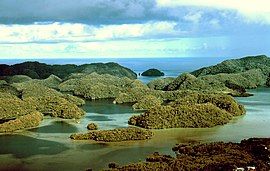Southern Lagoon of the Rock Islands
| Southern Lagoon of the Rock Islands | |
|---|---|
|
UNESCO world heritage |
|

|
|
| Aerial view of the Rock Islands from 1971 |
|
| Contracting State (s): |
|
| Type: | Culture / nature |
| Criteria : | (iii) (v) (vii) (ix) (x) |
| Area: | 100,200 ha |
| Buffer zone: | 164,000 ha |
| Reference No .: | 1386 |
| UNESCO region : | Asia and Pacific |
| History of enrollment | |
| Enrollment: | 2012 (session 36) |
Location of the southern lagoon of the Rock Islands in the Pacific Ocean (north of Australia). |
The southern lagoon of the Rock Islands , also known as the Chelbacheb Islands, English Rock Islands Southern Lagoon , is the only UNESCO World Heritage Site of the oceanic island state of Palau .
scope
The world heritage site comprises around 100,200 hectares of 445 uninhabited limestone islands of volcanic origin, which are scattered within a sea lagoon protected by a barrier reef . Its area has clear boundaries and includes a large part of the lagoons and reefs around the main islands of Palau as well as most of the islands of coral origin of the state of Koror .
history
Finds in the world heritage site show that the now uninhabited islands were once settled. Archaeological relics and rock art sites have been found on the two archipelagos Ulong and Ngemelis and on the three islands of Ngeruktabel , Ngeanges and Chomedokl . These testify to seasonal human settlement and use of the marine or sea-adapted ecosystem, which goes back up to 3100 years.
Permanent stone villages on some islands, which emerged between 1050 and 1500, were inhabited for several centuries and abandoned around the 17th and 18th centuries when the population moved to the larger islands. Today there are still remains of these villages such as defensive walls, terraces and platforms on which houses once stood. According to the World Heritage Commission, these settlements reflect an unmistakable response to their environment, and their abandonment highlights the consequences of population growth and climate change in a limited environment.
fauna
The lagoon contains the largest number of marine lakes in the world with 52 . According to their sometimes different geological and ecological stages of development, these range from lakes very well connected to the sea to very isolated lakes. For this reason, unique and endemic species developed at this location and researchers use this area for studies on evolution and species formation. For example, five subspecies of the umbrella jellyfish Mastigias papua were discovered in the lakes .
In total, over 746 species of fish , 385 species of coral , 13 species of shark and manta ray as well as 7 species of giant clams and pearl boats as well as the entire threatened megafauna of Palau can be found in the area of the World Heritage Site. In addition, all birds , mammals , amphibians and reptiles endemic to Palau live in the forests of the islands . Mainly thanks to the extraordinary diversity of reef habitats, minimal pollution, low fishing activity and overall the barely noticeable human influence, the ecosystem in this place has developed in such a unique way.
Individual evidence
- ↑ a b c UNESCO World Heritage Center: Rock Islands Southern Lagoon. Retrieved September 24, 2020 (English).
Coordinates: 7 ° 14 ′ 48.9 ″ N , 134 ° 21 ′ 9 ″ E
